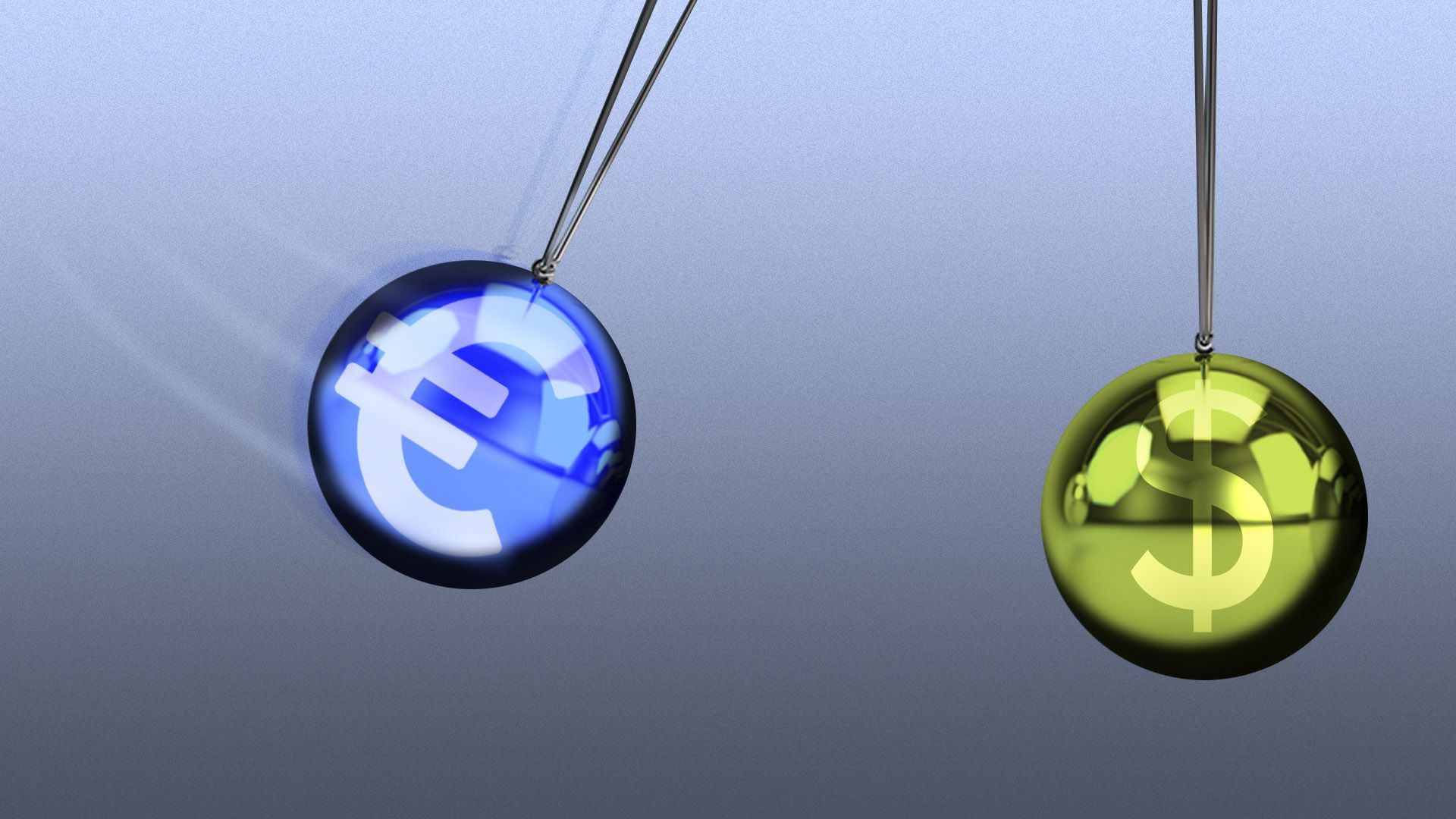| | | | | | | Presented By Flatfile | | | | Axios Markets | | By Dion Rabouin ·Feb 04, 2021 | | Good morning! Was this email forwarded to you? Sign up here. (Today's Smart Brevity count: 1,343 words, 5 minutes.) ⛪️ Trivia: Who was the Peruvian priest beatified in 1837 by Pope Gregory XVI and canonized in 1962 by Pope John XXIII, now known as the patron saint of mixed-race people, barbers, innkeepers, public health workers and all those seeking racial harmony? | | | | | | 1 big thing: Trouble brewing in the eurozone |  | | | Illustration: Sarah Grillo/Axios | | | | Increasing lockdowns, a mutating virus and a botched vaccine rollout have the eurozone headed for a double-dip recession, weighing heavily on its currency and pushing the dollar higher. Why it matters: The weak dollar (down 10% from its 2020 highs) has been a linchpin for some of the biggest consensus trades this year — strong commodities, skyrocketing U.S. equity prices and emerging market stocks and bonds. - A weakening euro — the largest component in the value of the dollar index — means a stronger dollar, which could halt or reverse those trades.
- The economic slowdown could force the hand of the European Central Bank to further lower interest rates below -0.5% or deliver even more extreme monetary policy easing, further weighing on the euro.
The big picture: The ongoing crisis in the eurozone — where GDP in the fourth quarter was -0.7% and economists are predicting another quarter of negative growth for Q1 this year — is running in direct opposition to the bounceback seen in the U.S., which boasted 4% growth in Q4. - Bank of America Securities notes that the euro has been one of the "greatest underperformers" among the world's major currencies.
- Kathy Lien, managing director of FX strategy for BK Asset Management, pointed out in a note to clients that the euro extended its fall against the dollar despite better than expected economic data earlier this week, "which goes to show that once sentiment shifts, it can have a lasting impact on a currency."
By the numbers: The euro has fallen for three straight days and touched its lowest against the dollar since Nov. 30 on Wednesday. The continental currency also hit its weakest against the British pound in nine months. Between the lines: While growth has been nonexistent, signs of inflation have been popping up, pushing government bond yields higher. - Most recently, eurozone consumer price inflation hit an 11-month high of 0.9% in January, up from -0.3% in December, according to Eurostat. That was the biggest inflation jump in more than a decade.
- Core CPI rose by 1.4% on the year.
|     | | | | | | Bonus chart: The U.S.-Europe PMI split |  Data: Investing.com; Chart: Michelle McGhee/Axios Eurozone PMIs were revised higher in the month of January but remained below 50 for a composite of the manufacturing and services sectors, with services as the biggest drag, having fallen for five months straight. - Overall private sector output declined for the third consecutive month and at an accelerated rate, IHS Markit reported.
- Ireland's composite PMI fell to its lowest level in eight months.
- Germany's fell to its lowest in seven months.
- Italy fell to its lowest in three months and Spain and France both fell to their lowest in two months.
The other side: U.S. services and manufacturing both jumped in January, with the services sector reporting especially strong growth. - "The rate of growth was the second-sharpest in almost six years, with firms linking the upturn to stronger client demand and an increase in new business," IHS Markit noted in a release.
- "January data indicated a strong rise in new orders."
Don't sleep: IHS Markit also highlighted a notable pick up in U.S. businesses' costs — another sign of creeping inflation. - "[C]ost burdens soared once again, with the rate of input price inflation the fastest since the survey began in 2009. Firms largely passed on higher costs to clients through a marked rise in charges."
|     | | | | | | 2. Catch up quick | | A third of small businesses say they are unlikely to survive without more government assistance, according to a new Fed survey. (NY Times) The SEC has been searching social media posts for signs of fraud in the retail buying frenzy. (Bloomberg) PayPal announced it added a record 72.7 million active accounts in 2020 and its revenue ran away from consensus as pandemic-buying fueled growth. (Bloomberg) EBay's gross merchandise volume for the quarter rose 21% to $26.6 billion, thanks largely to the company's big sales of luxury watches and sneakers, and said its total ad revenue passed $1 billion for the year. (MarketWatch) |     | | | | | | A message from Flatfile | | How 100+ businesses migrated customer data in 2020 | | |  | | | | Data migration is a covert challenge for startups through enterprises. - 96% of companies surveyed by Flatfile ran into problems when importing data – 23% said migrating data takes weeks.
Read the 2020 State of Data Onboarding report for more insights. | | | | | | 3. Inflation expectations hit highest since 2013 |  Data: Federal Reserve Bank of St. Louis; Chart: Axios Visuals U.S. inflation expectations continue to rise, as the 5-year breakeven rate rose to its highest in nearly eight years on Wednesday. What's happening: Inflation expectations are rising at a torrid pace thanks largely to massive lending by the Fed and big government stimulus programs, with both expected to continue at a sizable pace for some time. - The 10-year breakeven rate and 30-year breakeven rate, which measure expectations of inflation over those time periods, also rose to fresh highs.
ICYMI: The University of Michigan's January consumer sentiment index fell to 79.0, down from its average of 81.5 in 2020, and well below the average of 97.0 from 2017 to 2019. - However, one-year-ahead inflation expectations ticked up to 3% from 2.5% in December, while 5- and 10-year inflation expectations rose to 2.7%.
Flashback: "Right now everybody thinks we're going to get reflation — that's real growth going forward," Jim Bianco, president of Bianco Research, told me on the latest Voices of Wall Street podcast last month. - "If that morphs itself into inflation that could be [a problem] for financial markets throughout the second half of the year."
- "If we get to 2.6% or 2.7% on the core [inflation] number that's the highest level we would have in 30 years," Bianco noted.
|     | | | | | | 4. New data show few Americans borrowed from retirement |  Data: Investment Company Institute; Chart: Axios Visuals A survey last month from Kiplinger and digital wealth management company Personal Capital found that 60% of respondents had taken some form of withdrawal from their IRA or 401(k) during the coronavirus pandemic, but new data suggests those numbers were a bit high. - Kiplinger has since amended its results and reports that just "a third of respondents took a distribution or loan from their retirement account."
Driving the news: Those numbers better align with a new report from the Investment Company Institute, which tracks retirement plan assets. - "A strong majority (65 percent) of US individuals did not take financial actions as a result of COVID-19," ICI's survey finds.
- The other 35% took a variety of actions, namely using emergency savings and credit cards.
What they're saying: "The survey findings are consistent with the data ICI has published throughout the pandemic based on actions reported by recordkeepers to defined contribution (DC) retirement plans," ICI says. (Defined contribution plans are mainly 401(k)s and similar plans rather than pensions.) - Through the first three quarters of 2020, ICI's data found that 3.4% of plan participants took withdrawals from their DC accounts, including 1.2% who took hardship withdrawals.
- DC plan recordkeepers identified 4.4% of DC plan participants who took CARES Act coronavirus-related distributions.
- At the end of September 2020, 15.4% of DC plan participants had loans outstanding.
Keep it 💯: "Together, these two sets of data—the self-reported actions from the survey and the administrative recordkeeper data based on actual DC account activity—contradict claims that large numbers of savers turned to withdrawals or loans from retirement plans in response to COVID-19 financial stress," ICI analysts say in their report. - "To the contrary, Americans appear to have placed a high priority on preserving their retirement savings."
|     | | | | | | 5. Pot stocks take another leg up after GW Pharma acquisition |  Data: FactSet; Chart: Axios Visuals Cannabis companies continued to blaze higher on Wednesday, boosted by the announcement that mainstream sleep medications company Jazz Pharmaceuticals would acquire GW Pharmaceuticals, developer of Epidiolex, a marijuana-based drug that won FDA approval as a treatment for severe forms of childhood epilepsy in 2018. By the numbers: U.K.-based GW Pharma shares jumped 46% and pot stocks rallied broadly, gaining on their already impressive 2021 surge. - Shares of Aphria gained 12.6% on the day.
- Cronos rose 8.1%.
- Tilray added 12%.
Be smart: "We don't think this is the last deal we will see in the sector," Nawan Butt, portfolio manager of the Medical Cannabis and Wellness ETF CBD, told MarketWatch. - "It is also another example that the cannabis industry is continuing to normalize and evolve beyond the traditional cultivation of flower, with potential well outside of our borders," Jason Wilson, cannabis and banking expert at ETF Managers Group, which manages the ETFMG Alternative Harvest ETF, said in the article.
- "For investors, the acquisition of GW Pharma is another reminder that investing in cannabis touches many verticals globally, requiring a diverse approach beyond traditional cannabis cultivation companies."
Go deeper: Pot stocks boom as industry sees prohibition ending |     | | | | | | 6. Oil rises to 1-year high |  Data: FactSet; Chart: Axios Visuals Oil prices rose almost 2% on Wednesday, with a barrel of U.S. West Texas Intermediate (WTI) crude touching its highest since January 2020. - The jump in oil prices followed government data showed that U.S. crude stockpiles fell to their lowest since March, while OPEC+ maintained its supply cut agreement.
|     | | | | | | A message from Flatfile | | How 100+ businesses migrated customer data in 2020 | | |  | | | | Data migration is a covert challenge for startups through enterprises. - 96% of companies surveyed by Flatfile ran into problems when importing data – 23% said migrating data takes weeks.
Read the 2020 State of Data Onboarding report for more insights. | | | | Thanks for reading! Trivia: A Peruvian priest who was beatified in 1837 by Pope Gregory XVI and canonized in 1962 by Pope John XXIII, this man is known as the patron saint of mixed-race people, barbers, innkeepers, public health workers, and all those seeking racial harmony. Answer: St. Martin de Porres, the illegitimate son of a Spanish aristocrat and a freed slave from Panama, who after years of denials because of his race was admitted into the Dominican Convent of the Rosary in Lima and was received as a servant. - He eventually became the church officer in charge of distributing money to the poor.
| | | | Axios thanks our partners for supporting our newsletters.
Sponsorship has no influence on editorial content. Axios, 3100 Clarendon Blvd, Suite 1300, Arlington VA 22201 | | | You received this email because you signed up for newsletters from Axios.
Change your preferences or unsubscribe here. | | | Was this email forwarded to you?
Sign up now to get Axios in your inbox. | | | | Follow Axios on social media:    | | | | | |









No comments:
Post a Comment